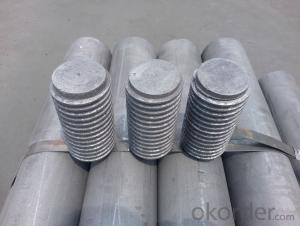When we talk about 300mm graphite electrodes, we’re diving into a world of industrial might and precision. These aren’t your everyday pencils or charcoal for sketching. No, these are the powerhouses of the metallurgical and electrochemical industries, playing a pivotal role in processes such as electric arc furnaces (EAF) and ladle furnaces. But let’s not get too technical just yet; let’s explore the heart and soul of these graphite wonders.
Imagine a rod, sleek and strong, with a diameter of 300 millimeters. That’s no small feat, especially when it’s made from graphite, a material known for its versatility and conductivity. The journey of a 300mm graphite electrode begins with the selection of the finest needle coke and coal tar pitch, the very essence of its being. These raw materials undergo a meticulous process of mixing, molding, and baking to form a prebaked structure that is both robust and ready for the challenges ahead.
As these electrodes take shape, they’re subjected to a rigorous series of quality checks. Each one is scrutinized for its density, electrical resistivity, and mechanical strength. The goal? To ensure that these graphite giants can withstand the intense heat and pressures they’ll face in their working environment. And trust me, it’s not for the faint-hearted. The temperatures can soar up to 2000 degrees Celsius, a true test of their mettle.
Now, let’s get to the applications where these 300mm graphite electrodes truly shine. In the world of steel production, they’re the unsung heroes. By conducting electric currents in EAFs, they help in melting scrap metal, transforming it into valuable steel. They’re not just limited to steel, though. These electrodes also find their place in the production of silicon, ferroalloys, and other metals, proving their versatility in the metallurgical realm.
But the story doesn’t end there. The electrochemical industry also owes a debt of gratitude to these graphite electrodes. They’re integral to processes like electrolytic production of aluminum, where they serve as the anode, facilitating the extraction of aluminum from its oxide. It’s a delicate balance of power and chemistry, and these electrodes are the linchpin that holds it all together.
As we marvel at the capabilities of 300mm graphite electrodes, it’s important to recognize the environmental considerations. The production process is continuously being refined to minimize emissions and waste, ensuring that these industrial powerhouses can coexist harmoniously with our planet.
In a world that’s constantly evolving and demanding more from its materials, 300mm graphite electrodes stand as a testament to human ingenuity and the pursuit of excellence. They’re more than just tools; they’re the backbone of industries that shape our modern lives. So, the next time you see a steel beam or a piece of aluminum, remember the humble graphite electrode that played its part in creating it.
In conclusion, 300mm graphite electrodes are not just components in a larger machine; they’re the unsung heroes of the industries they serve. Their specifications and applications are a dance of science, technology, and environmental responsibility. As we continue to innovate and push the boundaries of what’s possible, these graphite electrodes will undoubtedly continue to be a vital part of our industrial landscape.

